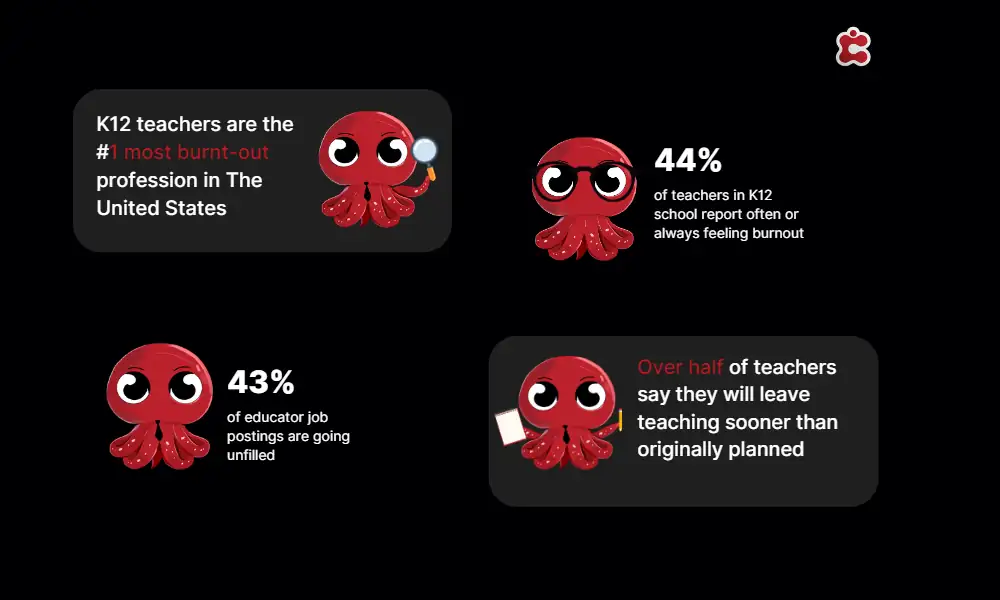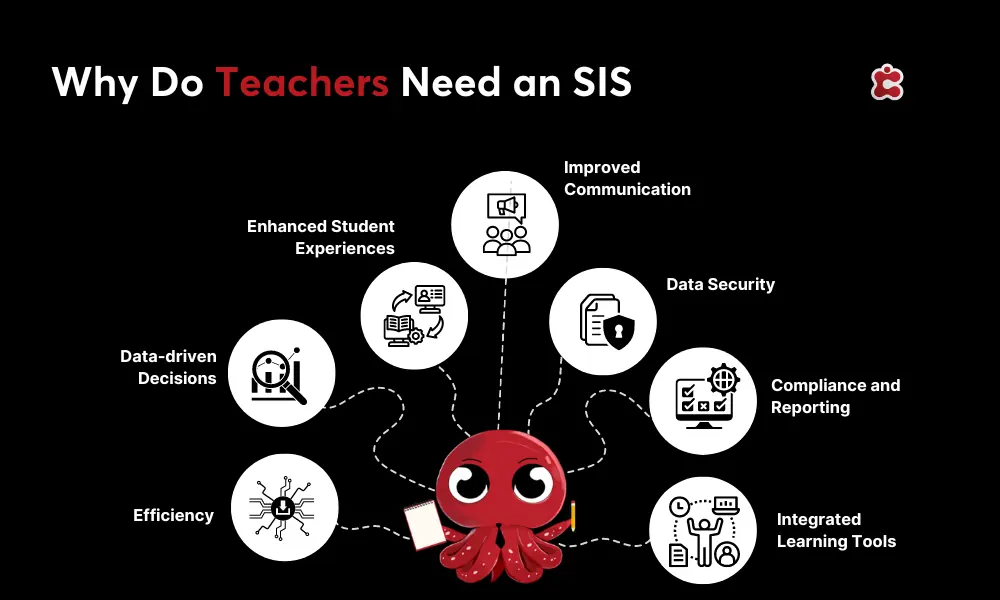There is nothing more frustrating than sidelining your passion to complete mundane administrative tasks. Teachers spend hours each week on grading, tracking attendance, and managing data—time that could be spent crafting engaging lessons or connecting with students.
Balancing teaching with a growing pile of paperwork is no easy feat. It often feels like there’s just not enough time in the day, leading to stress and burnout. But what if you could get that time back?
Student Information Systems (SIS) are powerful tools designed to automate routine tasks, making administrative work quicker and more efficient. By handling everything from grading and attendance to data management, SIS allows teachers to focus on what truly matters.
We’ll dive into how SIS can help you reclaim your time and passion. We’ll uncover the specific tasks that can be automated with your SIS and show you how to use these systems to make your day more productive and fulfilling.

Time Drain of Administrative Tasks
If you’ve ever felt overwhelmed by the sheer volume of paperwork on your desk, you’re not alone. Research shows that 53% of primary and 61% of secondary school teachers believe they are spending too many hours on grading—tasks that pull them away from the heart of their job: teaching.
Think about it: grading assignments, tracking attendance, managing schedules, and entering data. These routine tasks, while necessary, can easily consume a significant portion of your workweek. Grading papers alone can take hours, and keeping accurate attendance records involves constant updates and checks. Add to that the complexities of scheduling and the ongoing data entry required for student records, and it’s no wonder that administrative duties feel like a never-ending cycle.
The real issue here is the impact these tasks have on your teaching. When you’re bogged down with paperwork, it leaves less time for lesson planning, student engagement, and one-on-one support. Instead of focusing on crafting interactive lessons or providing personalized feedback, you’re stuck juggling spreadsheets and paperwork.
Automating Routine Tasks with SIS
Let’s take a look at what tasks can be automated with a Student Information System and how these changes can truly transform your teaching experience.
Automated Grading
One of the most time-consuming tasks for teachers is grading. SIS systems can handle this by automatically grading quizzes and assignments and providing instant feedback to students. Imagine the freedom of having more time to focus on personalized instruction and lesson planning rather than being buried in piles of papers. Automated grading not only speeds up the process but also ensures that students receive timely feedback to improve their learning.
Attendance Tracking
Tracking attendance manually can be tedious and error-prone. SIS automates attendance processes, from recording absences to generating reports, with a few clicks. This means less time spent on paperwork and more accurate records. By reducing the administrative workload, you can dedicate more time to engaging with your students and enhancing their learning experiences.
Class Scheduling
Managing class schedules and room assignments can often lead to conflicts and inefficiencies. With SIS, scheduling becomes a streamlined process. The system automatically handles room assignments and adjusts schedules as needed, minimizing conflicts and optimizing resource use. This makes your day-to-day operations smoother and frees you up to focus on teaching and connecting with your students.
Data Management
Lastly, SIS automates the generation of reports and the tracking of student data. This quick access to important information helps you make better-informed decisions and spend less time on data entry. With more efficient data management, you can focus on developing strategies to improve student outcomes and overall classroom effectiveness.
More Time for Teaching
With the routine tasks automated and your time freed up, you’re left with a golden opportunity to enhance your teaching in ways you might have only dreamed of. One of the most exciting ways to use your extra time is by diving deeper into curriculum development. Utilize this time to explore new teaching methods, integrate innovative technologies, and adapt your materials to better meet your students’ needs. SIS can support this process by providing insights into student performance and areas needing improvement, helping you align your curriculum with your student’s strengths and challenges.
Another exciting possibility is the ability to tailor your instruction to each student’s unique needs. With the additional time, you can analyze data from SIS to identify individual learning styles and gaps. This allows you to create personalized strategies that address specific challenges and capitalize on each student’s strengths.

More Time for Collaboration
When administrative tasks are removed from your plate, you have a valuable opportunity to collaborate with your fellow educators. Imagine having the chance to sit down with other teachers to brainstorm lesson plans, share insights, and develop new strategies. With SIS, this collaboration becomes even easier. The system often includes features for sharing resources, accessing shared calendars, and communicating seamlessly.
Beyond lesson planning, time for collaboration allows teachers to explore and utilize shared resources. SIS can help in this area by providing a centralized hub where educational materials, teaching aids, and best practices are stored and easily accessible. By pooling resources and knowledge, teachers can create a more dynamic and engaging learning environment for their students.
More Time for Building Student Relationships
With the administrative burden lifted, teachers gain invaluable time to invest in what matters most: building strong relationships with their students. These connections can profoundly impact student success and create a positive learning environment.
Here’s how SIS can help teachers build stronger relationships with their students:
- Personalized Insights: SIS provides detailed data on student performance, attendance, and behavior. This information allows teachers to identify students’ strengths and areas for improvement.
- Efficient Communication: SIS often includes communication tools that facilitate easy and regular contact with students and their families. Teachers can send messages, updates, and feedback directly through the system.
- Tracking Student Progress: With automated reports and progress tracking, teachers can monitor each student’s growth and challenges in real-time. This helps in having more meaningful and informed conversations with students.
- Setting Up Support Systems: SIS can help identify students who may need additional support, allowing teachers to provide timely and targeted assistance.
Classter Gives Teachers More Time
At Classter, we understand that teaching is more than just delivering lessons; it’s about inspiring and supporting students. That’s why our Student Information System is designed to take the load off teachers’ shoulders by automating routine administrative tasks. Let’s dive into how Classter helps streamline your workday and give you back what matters most—your time.
Classter’s SIS automates essential tasks such as grading, attendance, and data management. With automated grading, you can quickly evaluate assignments and provide timely feedback without the usual pile of paperwork. Attendance tracking is also a breeze; our system simplifies the process and keeps accurate records, reducing the time you spend on these administrative chores.
Ready to see how Classter can transform your teaching experience? Explore Classter’s SIS today and discover how our platform can help you reclaim your time and elevate your teaching.
FAQ’s
SIS automates routine administrative tasks like grading, attendance, and data management. This reduces manual effort, speeds up processes, and minimizes errors, allowing teachers to spend more time teaching and interacting with students.
SIS includes features that facilitate collaboration among teachers, such as shared resources, access to shared calendars, and communication tools. These features help educators work together on lesson planning, share best practices, and develop effective teaching strategies.
Classter’s SIS includes integrated messaging and notification systems that facilitate clear and consistent communication between teachers, students, and parents. This feature helps keep all stakeholders informed and engaged, fostering a supportive educational environment.

